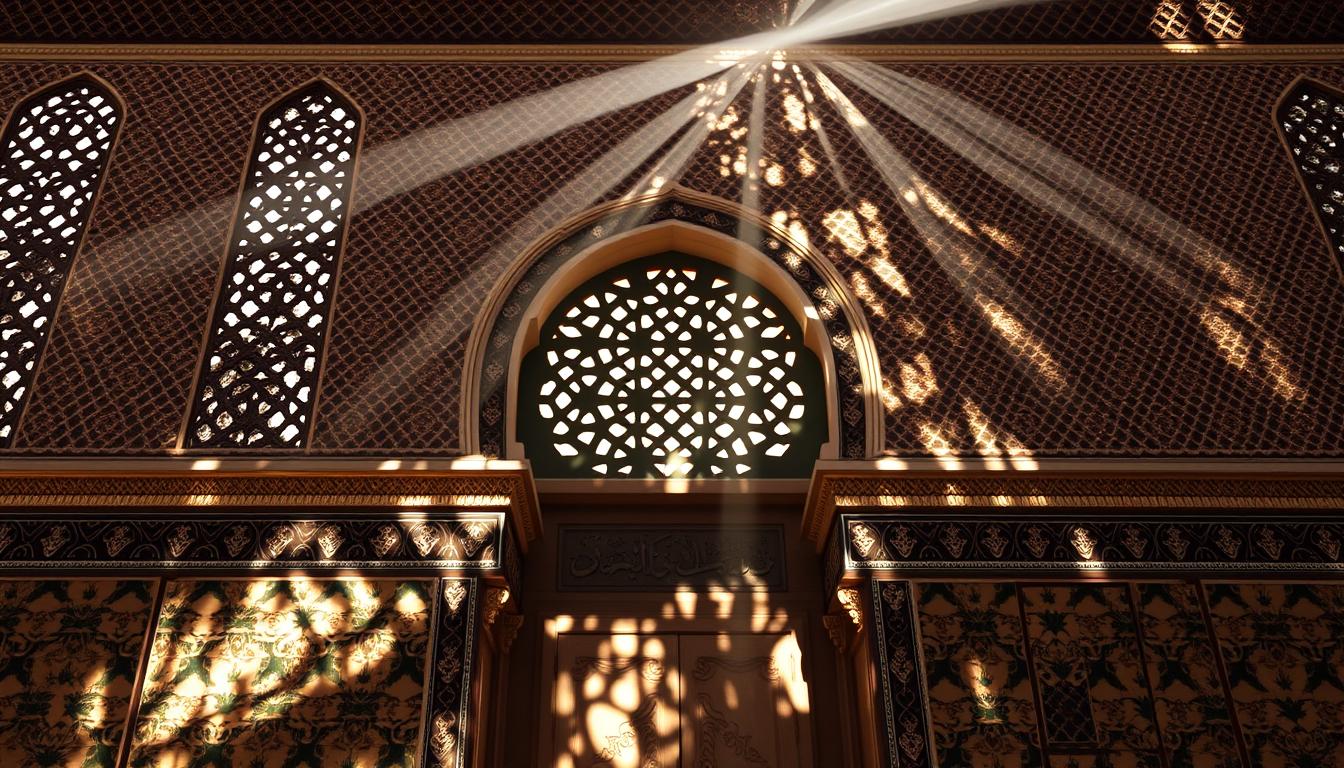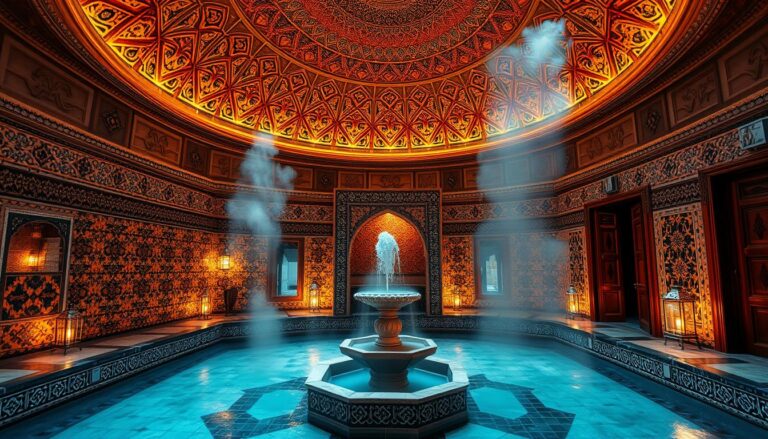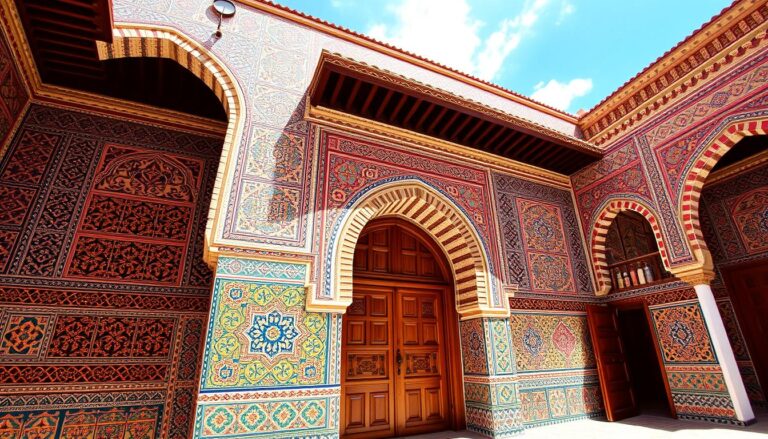Imagine walking into a place where light and shadow move together in a beautiful dance. This is what Moroccan architecture is all about. It’s known for its amazing use of light and shadow. The intricate patterns from latticework and the dramatic light and dark in mosques show its skill in using light and shadow.
What secrets do Moroccan buildings hold in their shadows? How do the experts use light to change the look of buildings? Explore Moroccan architectural lighting and see the magical world of shadow play that has amazed people for centuries.
Key Takeaways
- Moroccan architecture is famous for its detailed use of light and shadow to make amazing spaces.
- Techniques like chiaroscuro and contrast lighting are used to show off textures, embroideries, and details.
- The way light is placed and shadows are moved adds drama and a theatrical feel.
- Features like horseshoe arches, geometric shapes, and detailed decorations are key in Moroccan design, enhanced by light and shadow.
- The Moorish influence is seen in the focus on interior design and the use of light to create mystery and depth.
Introduction to Moroccan Architectural Lighting
Moroccan architecture is known for its amazing light and shadow play. This creates a dramatic and theatrical feel. The unique lighting techniques add warmth, depth, and luxury to its interiors.
Illumination Techniques and Dramatic Effects
Moroccan designers use architectural lighting to show off the intricate details in their interiors. Accented lighting, like Optec contour spotlights, brings out the textures and designs. This makes the designs look three-dimensional and adds to the dramatic effects.
Chiaroscuro Effects and Contrast Lighting
Moroccan architecture also uses chiaroscuro effects and contrast lighting to create bold shadows and highlights. This light and dark play adds to the drama and atmosphere. It takes visitors on a journey through the captivating Moroccan design.
“Moroccan architecture utilizes a range of illumination techniques to create dramatic and theatrical effects.”
Lighting and Shadow Play in the Great Mosque of Cordoba
The Great Mosque of Cordoba is a marvel of the western Islamic world. It showcases the art of lighting and shadow play in Moroccan design. The vast hall, with its columns and arches, creates a dance of light and shadow.
Accented Lighting Highlighting Textures and Embroideries
Light sources inside the mosque highlight the textures and embroideries. This accented lighting brings depth to the mosque’s decorations. The light and shadow play adds to the grandeur, making it a theatrical experience.
Sense of Drama through Theatrical Lighting
The theatrical lighting in the Great Mosque of Cordoba adds drama. The light and dark play creates deep shadows across the hall. This dramatic effect is enhanced by the mosque’s detailed architecture.
“The Great Mosque of Cordoba is a true masterpiece of Islamic architecture, where light and shadow converge to create a mesmerizing and unforgettable experience.”
The Great Mosque of Cordoba is a masterpiece of light and shadow. Its design combines light, textures, and architecture for an immersive experience. It is a place of wonder for all who visit.
Lighting and shadow play in Moroccan Architecture
The way light and shadow dance in Moroccan architecture is key to its charm. Intricate designs and patterns come alive with light, making spaces feel dramatic and special. This creates a unique visual experience.
Light and shadow are at the heart of Moroccan design. Thick walls, made from materials like mud or stone, help create these effects. They also keep the space cool, adding to the magic.
The Zellige mosaic tiles, made by hand, show off bright colors and precision. The Gebs, with their detailed carvings, add to the light and shadow show. This shows the deep commitment to craftsmanship in Moroccan design.
“The enchanting play of light and shadow through intricately crafted wood and stone work in Moroccan architecture serves as a reflection of the transient nature of life, encouraging contemplation and peace.”
Places like the Hassan II Mosque in Casablanca and the Jardin Majorelle in Marrakech are examples of this. Moroccan architecture uses light and shadow to create spaces that amaze and inspire. It shows the country’s rich culture and creative spirit.
The Influence of Moorish Architecture
Moorish architecture has deeply influenced Moroccan design. It comes from the western Islamic world. This style is known for its horseshoe arches, riad gardens, and detailed geometric and arabesque motifs.
Horseshoe Arches and Geometric Motifs
The Moorish style is famous for its horseshoe arches. These arches add elegance and drama. The surfaces are also decorated with intricate geometric patterns and arabesque motifs.
Interior Focus and Surface Decoration
Moorish design focuses more on the interior and surface decoration. It uses lighting and shadow to highlight these elements. This creates a captivating atmosphere and drama inside the buildings.
The Moorish architecture’s legacy still inspires Moroccan design today. It keeps the region’s rich cultural heritage alive. From Fez’s tilework to Marrakech’s palaces, Morocco’s architecture shows the beauty and skill of this style.
Early Islamic Monuments and Lighting Techniques
The earliest Islamic monuments in North Africa show how lighting and architecture evolved. The Great Mosque of Kairouan is a prime example. It was rebuilt in the 9th century by the Aghlabid dynasty.
The mosque has a beautiful dome in front of the mihrab. It has a decorated drum that stands out against the rest of the mosque. This mix of light and architecture is a key feature of Moroccan design.
The Great Mosque of Kairouan
The Great Mosque of Kairouan is a key early Islamic monument. It uses lighting techniques that Moroccan architecture later adopted. The mihrab wall is covered in stunning ceramics.
The mosque’s calligraphy shows great skill and precision. It uses geometric patterns and arabesques that show a deep understanding of math. The muqarnas adds to the visual complexity, making light and shadow play a key feature of Aghlabid architecture.
“The Great Mosque of Kairouan is a testament to the creative and technical brilliance of early Islamic architects, whose innovative use of lighting and architectural features paved the way for the distinctive Moroccan design we know and admire today.”
Marrakesh: A City of Light and Shadow
Marrakesh, in the heart of Morocco, is a city full of light and shadow. It sits between the dry landscape and the Atlas Mountains. This city is known for its beautiful buildings that show off the region’s art.
Theatrical Lighting at the Theatre Royal
The Theatre Royal is a great example of Moroccan architecture. Its entrance and roof are designed to catch the light. Inside, the light from windows and a rotunda creates amazing shadows and light.
Majorelle Garden: An Oasis of Light and Color
The Majorelle Garden was created by Jacques Majorelle. It’s a place where light and color come together. The blue villa and plants make a colorful oasis that draws people in.
“Marrakesh is a city that captivates the senses, where the interplay of light and shadow dances across the architecture, creating a mesmerizing spectacle that enchants all who visit.” – Yves Saint Laurent
Marrakesh is known for its light and shadow in buildings. From the Theatre Royal to the Majorelle Garden, the city’s beauty inspires many. It’s a place where history and culture meet, inviting all to see its magic.
The Role of Courtyards and Gardens
Courtyards and gardens are key in Moroccan architecture. They celebrate the beauty of light and shadow. These green spaces offer a calm break from the city’s noise, blending nature with built structures.
Menara Gardens: Reflecting Pools and Olive Groves
The Menara Gardens are a prime example of Moroccan design. They have a large olive grove over 900 years old. At their center is a big basin that collects water from the Atlas Mountains.
The basin’s reflective surface, against the snow-capped mountains, creates a peaceful spot. It’s where light and shadow dance beautifully.
Moroccan design is all about blending architecture, water, and nature. The Menara Gardens, with their pools and olive groves, show the beauty and skill of Moroccan courtyards and gardens. This beauty has lasted for centuries.
“The Menara Gardens, with their reflecting pools and olive groves, showcase the timeless beauty and craftsmanship that have defined Moroccan courtyards and gardens for centuries.”
Moroccan gardens often have water features like fountains and ‘rills’. They’re filled with citrus trees, fragrant flowers, and colorful plants. The gardens also feature zellige tiles in blue, green, and yellow.
Designing Moroccan gardens focuses on privacy with high walls and plants. It also values sustainability with local materials and plants. Traditional water management, like rainwater collection, is used too.
Conclusion
Moroccan architecture is known for its amazing light and shadow effects. These create spaces that feel dramatic and magical. The Great Mosque of Cordoba and Majorelle Garden are great examples.
These places show how lighting and shadow are key in Moroccan design. We’ve seen how they use light to highlight details and create drama. This makes Moroccan buildings stand out.
Light and shadow are more than just looks in Moroccan architecture. They add a special quality to these spaces. This tradition continues to inspire people all over the world.
Source Links
- Herzog & de Meuron
- 16 Beautiful Elements Found In Moroccan Bedroom Design
- An architectural review of a location: Morocco
- Marrakesh – Majorelle Garden – Adventure Patches
- Visiting the Great Mosque-Cathedral of Córdoba: an Art historian’s comprehensive self-guided Tour
- Islamic arts – Architecture, Mosques, Palaces | Britannica
- ISLAMIC ARCHITECTURE ⋆ Archi-Monarch
- Unlocking the Timeless Allure of Moroccan Architecture
- UNESCO – Shadow play
- Moorish architecture
- Islamic arts – Moorish, Architecture, Decoration | Britannica
- Unveiling the Timeless Beauty of Moorish Architecture in Morocco – Morocco Travel Buddy
- Islamic arts – Architecture, Decoration, Mosaics | Britannica
- The Beauty of Islamic Art and Architecture – Muslim Blocks
- Marrakesh in black and white, photo Friday
- The CSH Travel Guide: A winter escape to Marrakech – cate st hill
- Moroccan Doors – Exploring The Vibrant Colors Of Do In 2024
- Unveiling the Intriguing Beauty of Moroccan Garden Design
- The History and Evolution of Pergolas
- Maison Brummell Majorelle in Morocco comes alive with dreamy arched motifs
- Passive Strategies for Building Design in Tropical Climates: A Comprehensive Guide

The Editorial Team is a passionate group of Morocco enthusiasts dedicated to sharing the beauty, culture, and wonders of this captivating country. With diverse backgrounds and a deep love for travel, we strive to bring you engaging and informative content that inspires your Moroccan adventures. From uncovering hidden gems and sharing local insights to exploring mouthwatering cuisine and showcasing the vibrant lifestyle, our team is committed to providing you with valuable resources and exciting stories that enhance your exploration of Morocco. Join us on this journey as we celebrate the rich heritage and unforgettable experiences that make Morocco truly special.







